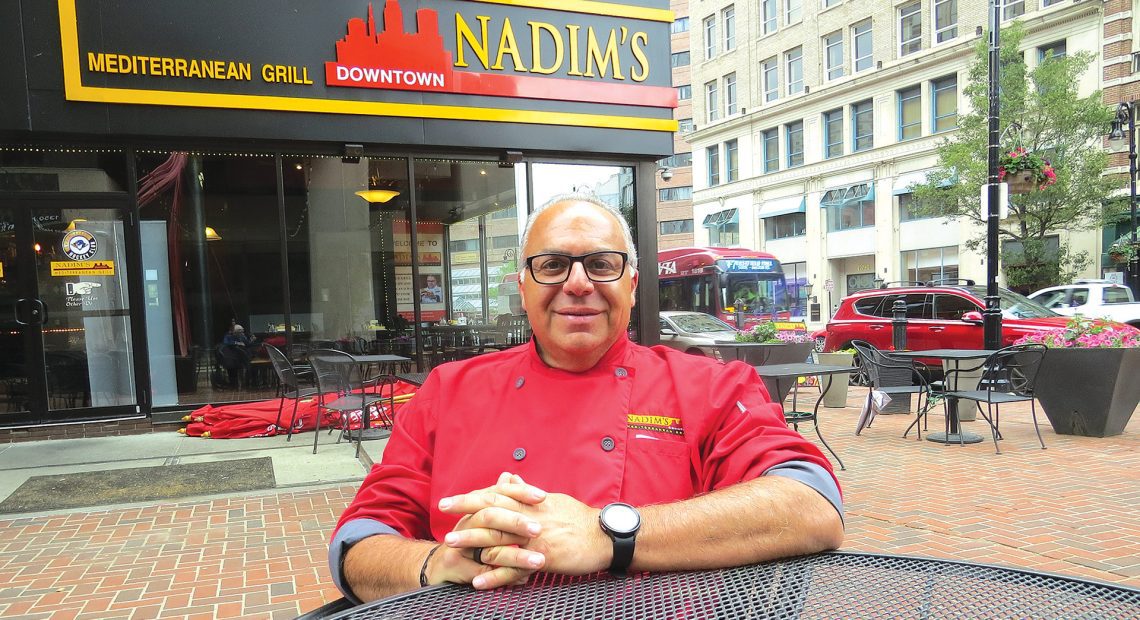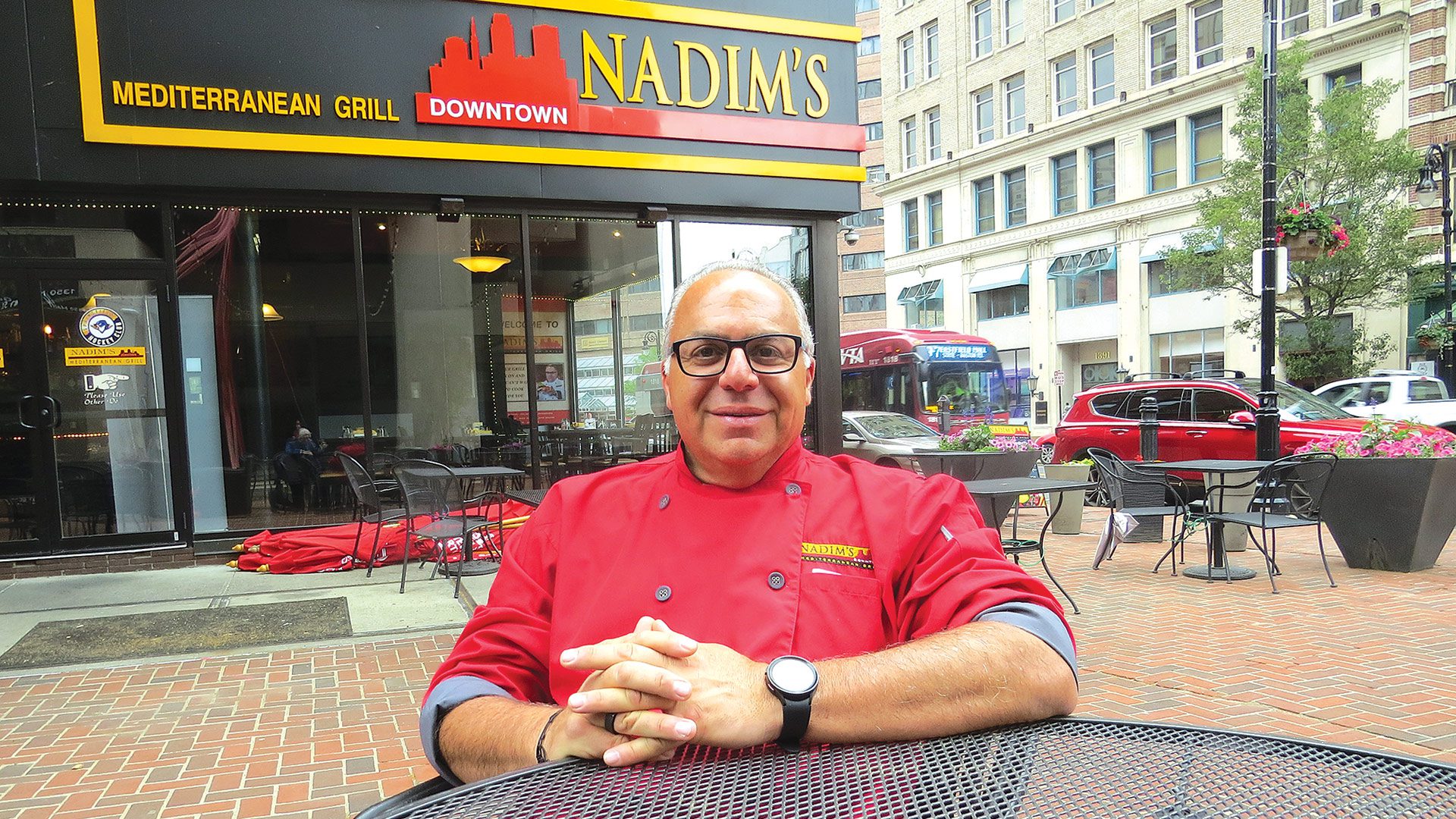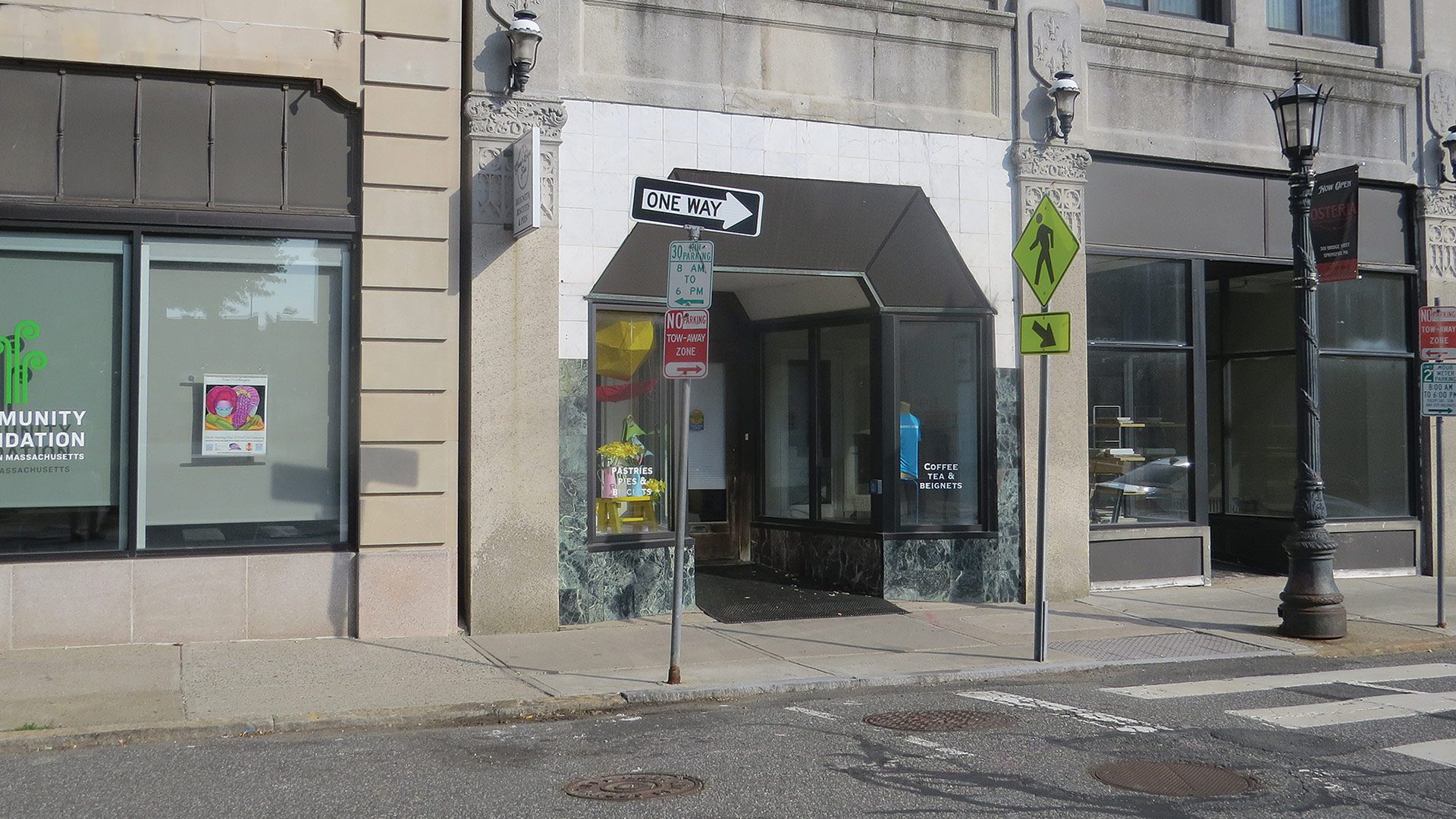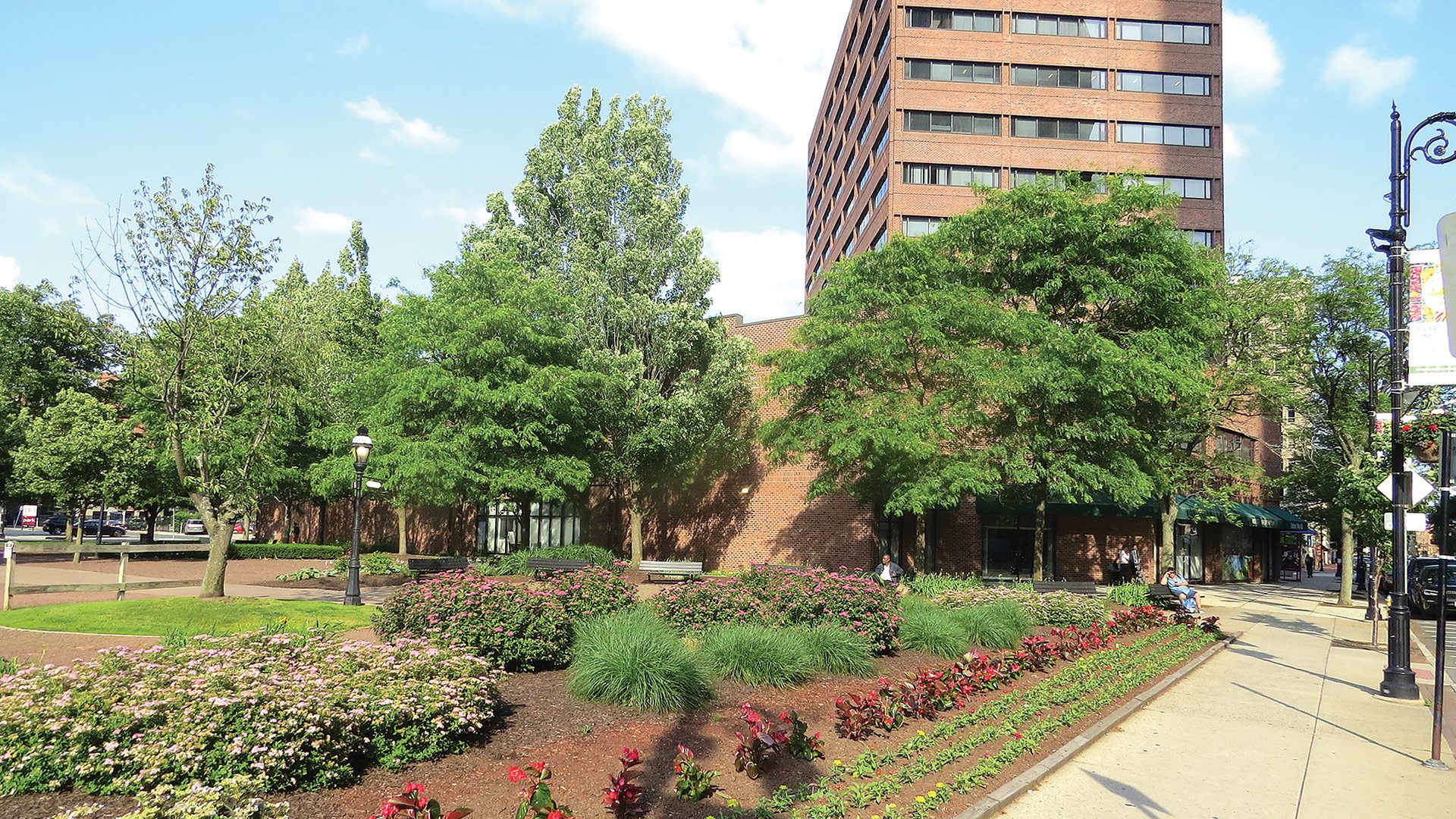
Springfield Program Strives to Take Dining Option to the Next Level
The Great Outdoors

Nadim Kashouh has long offered outdoor seating at his downtown Springfield establishment.
The term ‘parklet’ isn’t exactly new.
Larger municipalities like San Francisco, Philadelphia, Phoenix, Chicago, and others have been using it, officially or unofficially, for at least a few years now to describe efforts to repurpose and reimagine parking spaces for recreation, dining, retail, and other uses.
It’s starting to be heard more in Springfield, and it will certainly become a part of the lexicon in the future thanks in large part to $2 million worth of grants being awarded to area establishments and properties to take outdoor dining in the city to at least the next level.
Indeed, there will be at least a few parklets created through these grants, including one at Granny’s Baking Table on Bridge Street.
Todd Crossett, co-owner of the bakery, said he’s been researching the concept and, working with a local architect, has come up with a plan to bring the popular eatery, which features pies, pastries, beignets, and sandwiches, out into a large parking space originally meant for a van — 8 feet by 20 feet — and a few feet of the adjoining sidewalk, and thus bring something new and different to the city.
“We’re going to do something a little funky and take over a parking space,” he explained. “I think it will be the first of its kind, and it will be great for the city because it will generate more revenue than a parking space, because the space is free.”
Elaborating, he said Granny’s, drawing inspiration from what has been created in Evanston, Ill. and other communities, will create a tented, three-season dining deck that will include three tables and chairs as well as an awning, which can all be easily removed for the winter.
“We’re going to do something a little funky and take over a parking space.”
Beyond the parklets, though, the outdoor dining grants, funded by ARPA money awarded to the city in the wake of COVID, are expected to change the landscape in many different ways, from reactivating properties, such as the small park across Main Street from Tower Square, to changing the look and feel of other properties, such as the TD Bank building next to that park. It doesn’t have a restaurant at present — a pizzeria closed down during COVID, and a replacement has yet to be secured — but Jack Dill, who purchased the property in 2021 with a few partners, believes it will happen soon, and the option to serve patrons outdoors will likely help in the process of securing one.

Granny’s Baking Table plans a tented, three-season dining deck outside.
While the grants have become the subject of some controversy — a few city councilors have essentially accused Mayor Domenic Sarno of using the grant program as a way to reward supporters and perhaps create more of them during an intriguing and potentially challenging election year — most of the focus has been on what they might mean for individual businesses and sections of the city, especially downtown.
Tim Sheehan, the city’s chief Economic Development officer, said that, while there weren’t too many positives to come out of the COVID pandemic, especially when it comes to the hospitality industry, the emergence of outdoor dining — not just as a preference for patrons, but also as a catalyst for business growth and economic development — is certainly one of them.
“The restaurant businesses recognized that this is what patrons were looking for all through COVID,” he said, adding that, while the pandemic is officially over in most all respects, there remains a focus on public health and safety within this industry and thus a continued focus on providing outdoor dining opportunities.
Nadim Kashouh, owner of Nadim’s Downtown Mediterranean Grill on Main Street, agreed. He has long offered outdoor dining at his establishment, which abuts the office tower 1350 Main St. office tower and now extends to that property with outdoor seating through a lease arrangement, and said it has become an increasingly popular option for his patrons.
“The restaurant businesses recognized that this is what patrons were looking for all through COVID.”
“People feel more comfortable sitting in an open space in the open air,” he said, adding that, with his $100,000 grant from the program, he intends to add more seats, from the current 60 to 100, as well as industrial-strength umbrellas, fire tables, heaters, a tent, and a grill that will allow him to bring what he calls a “a different kind of dining experience to the area.”
“People can come up, select their meat, and we’ll cook it for them right there and then,” he explained, adding that he expects the initiative to bring more people to his eatery and the downtown in general.
For this issue and its focus on commercial real estate, BusinessWest talked with Sheehan and several restaurateurs and property owners about the outdoor dining grants and what they might mean for individual businesses, locations, and the proverbial big picture in the City of Homes.
Food for Thought
Crossett told BusinessWest that, as those at Granny’s were preparing their application for the outdoor dining grants, which they were encouraged by city officials to pursue, they did so with a specific mindset.
“We just didn’t want to give the city a reason to say no to us,” he explained, adding that this sentiment is reflected in everything from architect’s drawings and multiple bids on construction that accompanied the application to the very specific dollar amount requested.
Indeed, while most applicants rounded up, Granny’s requested $46,160. And that’s how much the city awarded the business.
Overall, 21 establishments applied for the grants, and 17 were awarded funds. Some of the awards matched or came close to what was requested, while others were a fraction of what was sought. And it was a diverse list of recipients, to be sure, with awardees ranging from the Student Prince Restaurant and the Fort to the John Boyle O’Reilly Club; from Two Guys Pizza on Page Boulevard to Uno Chicago Grill near the Basketball Hall of Fame.

Activating the park area outside 1441 Main St. could be a key element in bringing more dining options to the building.
Dollar amounts awarded ranged from $250,000 (City Line Café, the John Boyle O’Reilly Club, and White Lion Brewing) to $35,000 for the Springfield Business Improvement District to build on its improvements on Duryea Way.
There were scoring criteria, said Sheehan, listing everything from an initiative’s ability to encourage foot traffic and improve walkability in a neighborhood business district to whether an applicant had previously received ARPA money. And there were some broad goals behind the awards, but mostly an effort to promote outdoor dining and create more and better opportunities for the concept to spur growth and bring more diners to establishments.
The grant program, which was conceived just a few months ago and undertaken in aggressive fashion, recognizes that the landscape has certainly changed in this realm. In 2019, he explained, the city initiated a one-year pilot program for outdoor dining that did not garner much interest within the industry, with just a handful of applicants. In 2020, the City Council approved that pilot becoming permanent, he went on, adding that the broad objective was to activate commercial districts in specific neighborhoods.
But it wasn’t until the pandemic that the industry fully recognized the need to move to outdoor dining, he continued, adding that the grant program was initiated to help individual businesses and properties move into that realm, or move more aggressively, through initiatives ranging from parklets to White Lion’s reactivation of the Steiger’s park.
Speaking in broad terms, Sheehan said outdoor dining does more than provide an attractive alternative to the traditional experience.
“It heightens people’s engagement with the public realm that’s around them,” he explained. “And it begins to elicit the conversation of ‘how do we make the public realm better for everyone, not just diners, but also pedestrians? And how do we make the streets more accessible to all of the needs that we have relative to public rights of way?’ Because there’s growing competition for that space, whether it be bicyclists or pedestrians or outdoor diners.”
As he talked about his grant and what will happen with it, Crossett first went back in time, to the start of COVID, when many cities were gearing up for outdoor dining and providing assistance to establishments looking to enter that realm. He said he encouraged city leaders to do the same, but recalls that the response was somewhat lukewarm — ‘pusillanimous’ was the word he used.
Eventually, some money was made available, and Granny’s used it to put a few tables and chairs on the sidewalk, which was not a good fix, he said, because there simply isn’t much room on the sidewalk. The outdoor-dining grants come three years after most cities moved aggressively in this realm, he said, but they are at least a step in the right direction.
And while Crossett would prefer a cutout — similar to what the city has done on Worthington Street in front of Theodore’s and Jackalope because of the way they have slowed traffic down on those streets and enhanced outdoor dining opportunities — Granny’s will start with a parklet that he hopes to have ready for the Springfield Jazz & Roots Festival, slated for next month.
Designs on Growth
Meanwhile, other grants that were awarded will be used in different ways to introduce outdoor dining or enhance and expand already-existing outdoor facilities, Sheehan said.
At Nadim’s, for example, the grant will enable the restaurant to almost double the capacity of the outdoor dining that exists now, generating what Nadim believes will be more business overall, amid a growing preference for that dining option.
He acknowledged that outdoor dining has its limits — there’s essentially a five- to six-month window, from May to October — but it has become an important component of most restaurants’ business plans. And with more and better outdoor options, the city, and, especially its downtown, become more of a destination.
At 1441 Main St., the TD Bank building, Dill said he’s looking to essentially turn back the clock at that office tower, which once had a much larger retail and restaurant component (what he called a ‘mall’) on its first and second floors — the latter was actually connected to both the Steiger’s department store (now that aforementioned park) and Tower Square via airwalks — while also taking full advantage of the growing popularity of outdoor dining.
“People feel more comfortable sitting in an open space in the open air.”
He said the new ownership will be re-envisioning the former mall portion of the property and applied for a grant through the outdoor-dining initiative to lay the groundwork for such a facility at the property.
“We’re in early design now, but what we’re trying to do is position those underutilized parts of the building in ways that will more effectively address some non-traditional uses,” he said, adding that the plan is to find “the right operator” and then the right location within (and outside) the property for a dining operation.
“We have some flexibility,” he said, adding that there is space on more than one side of the building for an outdoor facility, including the area by the park. “We’ll want to work with the operator on what they want to accomplish from a design and operational standpoint.”
Dill said a restaurant would serve tenants in the property and neighboring office towers, obviously, but also be another key addition in a downtown that, by most accounts, needs more options for the people who come to the area for hockey games, concerts, gymnastics and dance competitions, and other gatherings.
“This is a logical place for part of that expansion to take place,” he said, adding that, while the number of office workers downtown has declined since the start of the pandemic, people are returning to offices, and he expects that trend to continue in the months and years to come.
Dill praised the entrepreneurs taking risks and opening new venues downtown, such as Jackalope and Osteria, two ventures on Worthington Street that are bringing more vitality, and people, to the area. And he said he hopes to add to the growing inventory of restaurants with an addition at 1441 Main St.
Such additions are part of the motivation behind the outdoor-dining grants, which, while small in size and scale in most respects, have the potential to have a big impact in terms of changing the landscape — figuratively and perhaps literally — and adding new words to the lexicon, like ‘parklet.’




